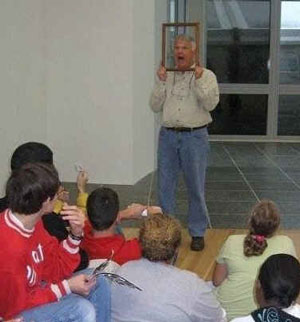Jim Flanagan – Storytelling and Writing are Intertwined.

|
|
||||
Jim Flanagan writes…
To tell a story, you must write it down.
Before you tell it, you must have a point of reference, an outline, and hen scratching a script.
After you tell the story, you refine, and you refine your written story too.
Writing a story leads the teller to be able to see if the tale flows, if it makes sense,
The writing defines the beginning, middle and end. You look at the words and play with the vocabulary and the phrases. You see where in the story, you will have to add emphasis. (You might even insert the directions to change your voice)
I would suggest you read it to someone, they act it out. This acting helps you see what you left out or the jumps in the story.
You tell the story and see how it relates to the written tale. If you revise or change a part put that into the written story.
If you do not, you will forget those changes.
After you have the story ready, read it over one more time. Now you can come up with the grabber sentence, the start to your story. The comment that makes the reader turns to the next page. This is the comment that catches the listener interest.
In my classes, I tell a story. I ask the class what caught their attention and why. I ask for points of suspense. How was the suspense set up? What words did I use that had an effect on the story.
You stop here and lead a discussion on vocabulary.
The difference in telling and writing is the amount of words you use in describing something. In writing, the description can go a page. In storytelling that is down to two to four words. This is the time to talk about using in new words for new stories.
I write down some trite over used words and draw a line through them. The next step is brainstorming. This is a concept that needs to be explained. Out of this exercise, a great vocabulary list is generated.
I urge storytellers to develop and keep a list of words, phrases and idioms. That keeps tellers and writers thinking about words and word choice.
The effect of tellers and writers is to have the audience been able to picture the scenes through the words.
In my area, the groups talk about what is scary? They discuss universal scary scenes and what make them frightening. This gives the teller information on what can be used to set a scary scene because there are definite things that portend scary.
Writing it down helps a storyteller to set that atmosphere.
What is suspense? Why do tellers and writers do this type of writing?
You have to consider twists and turns in your story. The audience, readers or listeners may have a clue where the story will end. AND you may want the tale to end there too. But you need to divert them, add the twists before you bring the audience to the end of the story. You may want to set up a situation to use it later in the story. How and why would you do this part of the story?
In stories, the character is king. Character should stand out. Physical characteristics are important but there are other ways to describe the characters in the story.
You can do that by asking questions to or about the character. For example, what does the character do when scared, when happy or when thinking about the scene?
The concept of describing the character in the beginning and again in the middle to bring the character into stronger focus. You develop a character bank to use in this story or for another tales.
You can learn more about James Flanagan on his website.
2 Comments
Other Links to this Post
RSS feed for comments on this post. TrackBack URI

By Mary Beth Spann, May 29, 2007 @ 2:54 pm
In my own teaching, children seem better equipped to come more willingly to the writing experience if they have first shared an oral storytelling experience. Aside from the points made in the podcast, I believe storytelling offers kids a language model that triggers memories and connections they long to express. Their writing then becomes an exchange of ideas, a conversation of sorts, with that of the storyteller’s.
By Jon Huckins, June 7, 2011 @ 11:59 am
Great insight and I totally agree. I just wrote a book titled Teaching Through the Art of Storytelling and I also put a significant emphasis on writing out our stories before delivery.